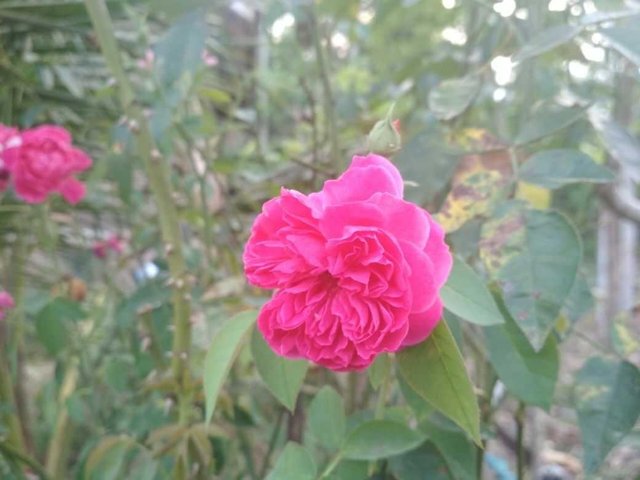Garden Roses are generally
Garden Roses are generally classified into 3 major groups:

Wild roses (Wild Rose): Originally grown wild, a simple flower shape, has been known to humans since ancient times. Some of the leading rose species mentioned above and some of the hybrids it produces are examples of wild roses.
Old Garden Roses: the cultivated plant before the introduction of Hybrid Tea in 1867. The flower shape is unique and smells nice. Here are the types of Old Garden roses arranged according to the age order of the oldest:
Alba: "white roses" crosses Rosa arvensis with Rosa alba. Alba is an example of the oldest Garden Rose, brought to England by the ancient Romans. Flowers once a year. Example: 'Semi-plena', 'White Rose of York'.
Gallica: the cross from Rosa gallica from central and southern Europe. Flowering once in summer. Example: 'Cardinal de Richelieu', 'Charles de Mills', 'Rosa Mundi' (Rosa gallica versicolor).
Damask - brought to Europe from Persia by Robert de Brie around 1254 and 1276. Summer Damasks roses (a cross between Gallica rose and Rosa phoenicea) bloom once in summer. Rose type Autumn Damasks (a cross between Gallica with Rosa moschata) flowering in autumn. Examples: 'Ispahan' and 'Madame Hardy'.
Centifolia or also known as Provence: literally means "a thousand leaves of the crown" is the result of glorification in the 17th century in the Netherlands. Flowers once a year, for example: 'Centifolia' and 'Paul Ricault'.
Moss: is still a close relative of Centifolia, the stems and leaves of petals like overgrown with green moss. Flowers once a year. Example: 'Comtesse de Murinais', 'Old Pink Moss'.
China: can bloom many times throughout the summer until the end of autumn. There are four types ('Slater's Crimson China' 1792, 'Parsons' Pink China '1793,' Hume's Blush China '1809, and' Parks 'Yellow Tea Scented China' 1824) brought into Europe at the end of the 18th century and century to-19. These types are then glorified into Old Garden roses that can be bloomed many times, such as 'Old Blush China' and 'Mutabilis'.
Portland: named to honor the Duke of Portland received a rose from Italy in 1800). Roses often known as' The Portland Rose '(another name: Rosa paestana or' Scarlet Four Seasons' Rose ') are the ancestors of the Portland roses. Examples: 'James Veitch', 'Rose de Rescht', 'The Portland Rose'.
Bourbon: A rose derived from l'Île de Bourbon (now called Réunion, French colony in the Indian Ocean) was introduced in France in 1823. The results of the 'Autumn Damask' and 'Old Blush China' crossings. Flowering many times. Example: 'Louise Odier', 'Mme. Pierre Oger ',' Zéphirine Drouhin '.
Hybrid Perpetual: The rose that is commonly found in England in Victorian times, is descended from Bourbon. Flowering many times. Example: 'Ferdinand Pichard', 'Reine Des Violettes'.
Tea: Rose crossed 'Hume's Blush China' or 'Parks' Yellow Tea Scented China' with various types of Bourbon and Noisette. Flowering many times though not always smells like tea. Example: 'Lady Hillingdon'.
Bermuda "Mysterious" Roses (Bermuda's "Mysterious" Rose): a group of several dozen Roses from Bermuda that have been cultivated for at least a century in Bermuda when "discovered." Most likely the Bermuda Rose is a branching or cultivar of the Old Garden Rose which is discarded because it is considered unusable. The Bermuda rose has a high economic value because it can be grown in tropical and semi-tropical regions. Roses of this type can flower in hot and humid weather. Resistant to damage caused by Nematodes and Black Spotted diseases that pose a threat to the cultivation of roses in hot and humid climates. The Bermuda Rose is called a "mysterious rose" because the original name of this type is no longer known and is only named after the park owner's name.
Selamt